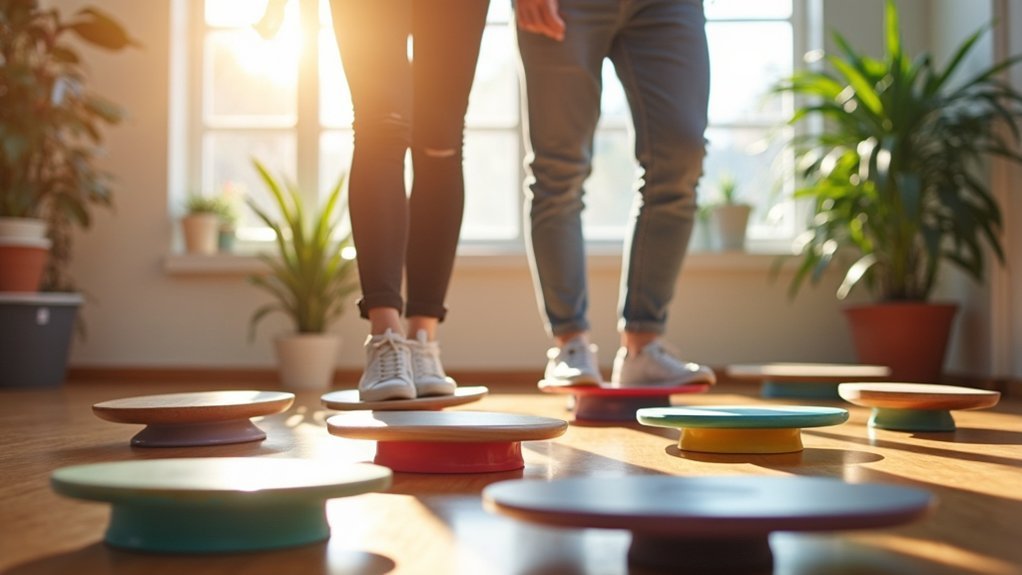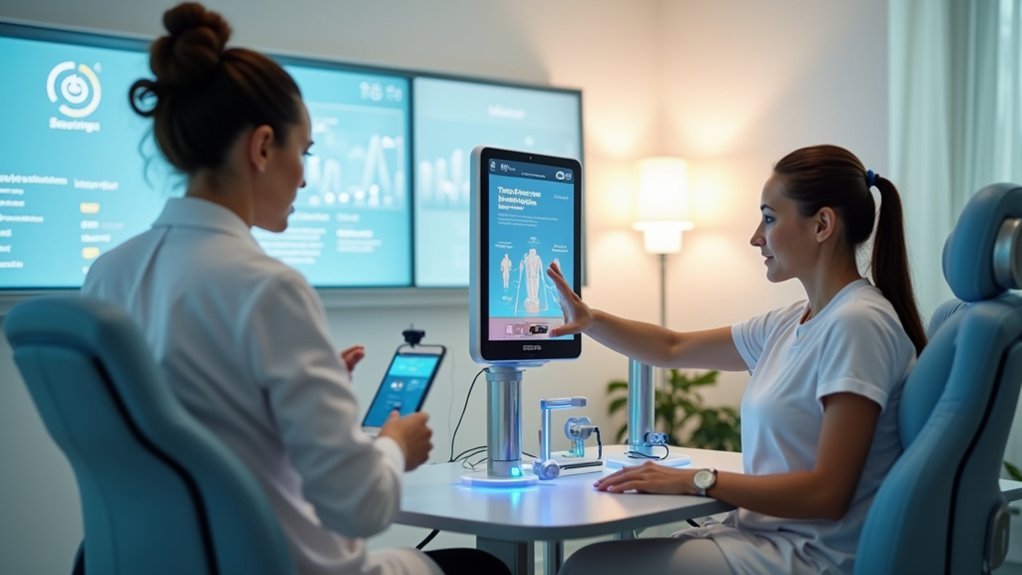The three most effective coordination tools for brain injury recovery include balance boards that rebuild neural pathways while improving stability, rhythmic movement devices that synchronize motions to enhance motor control, and smart therapy equipment offering real-time feedback to accelerate progress. You’ll benefit most from tools that provide customizable difficulty levels matching your recovery stage. Explore these options with your therapist to discover how technology-enhanced rehabilitation can transform your coordination journey.
Balance Boards and Stability Platforms for Rebuilding Neural Pathways

Three critical components of brain injury recovery—balance, coordination, and proprioception—can be greatly improved through the use of specialized stability tools.
Balance boards and stability platforms challenge your body’s equilibrium, forcing damaged neural pathways to rebuild through consistent practice.
During brain injury rehabilitation, these tools engage multiple muscle groups simultaneously, promoting neuromuscular re-education that’s essential for recovery.
You’ll notice improvements in postural control and core strength as your brain forms new connections.
Research shows that incorporating these devices into your recovery regimen considerably enhances functional mobility while reducing fall risk.
Many platforms offer adjustable resistance options, allowing you to progressively increase difficulty as you regain abilities.
This customizable approach guarantees your training aligns with specific recovery goals, making balance boards invaluable assets in your rehabilitation toolkit.
Rhythmic Movement Devices That Enhance Motor Control After TBI
Four innovative rhythmic movement technologies are revolutionizing traumatic brain injury rehabilitation by retraining damaged neural pathways.
Vibrotactile stimulators provide sensory feedback that greatly improves your coordination skills through consistent tactile input.
Pulsing vibrations on your skin create tactile input pathways, retraining coordination networks for smoother, more precise movements.
The NeuroMove device delivers rhythmic electrical stimulation to weak or paralyzed limbs, helping you regain motor control by activating vital neural connections.
For mobility improvement, rhythmic auditory stimulation technologies synchronize your movements with external beats, enhancing gait and balance performance.
Balance boards and rhythmic stepping platforms challenge you to maintain stability while performing coordinated movements, strengthening your body’s position awareness.
When incorporated into your regular rehabilitation program, these rhythmic movement devices consistently lead to improved functional independence, giving you greater control over daily activities after TBI.
Smart Therapy Equipment With Real-Time Feedback for Coordination Progress

While recovering from brain injury, you’ll benefit greatly from cutting-edge smart therapy equipment that provides immediate feedback during coordination exercises. These devices track your fine motor skills, helping you visualize progress and adjust movements instantly.
| Device Type | Benefits |
|---|---|
| Sensor gloves | Measure finger dexterity with precision |
| Balance boards | Track weight distribution and stability |
| Motion trackers | Analyze movement patterns during tasks |
| Gamified tablets | Increase engagement through interactive challenges |
| Wearable technology | Monitor coordination continuously throughout the day |
Real-time feedback accelerates your recovery by making rehabilitation programs more effective. The gamified elements keep you motivated during repetitive coordination tasks, while advanced sensors help therapists customize your treatment plan. You’ll experience faster improvements as these tools adapt to your specific needs and progress.
Frequently Asked Questions
What Are the Adaptive Equipment for Brain Injury?
Adaptive equipment for brain injury includes mobility aids like scooters and walkers, daily living tools, clothing aids such as shoe horns, and cognitive aids like labels and checklists to support your independence.
How Can I Speed up Recovery From Brain Injury?
You’ll speed up brain injury recovery through consistent physical therapy, cognitive aids, adaptive equipment, and brain-stimulating activities. Maintain a structured routine that balances rest, physical activity, cognitive challenges, and social engagement daily.
What Is the Best Recovery From a TBI?
The best TBI recovery combines personalized therapy, early intervention, and consistent practice. You’ll need a multidisciplinary approach including physical, cognitive, and emotional support. Don’t underestimate the power of your social network during rehabilitation.
What Are the Cognitive Assessment Tools for TBI?
You’ll find several effective cognitive assessment tools for TBI including the MoCA, MMSE, MACE 2, Neurobehavioral Rating Scale, and WAIS. These tests evaluate your memory, attention, and executive function to guide personalized rehabilitation plans.
In Summary
Through these specialized tools, you’ll gain back lost coordination skills one step at a time. Whether you’re using balance boards to rebuild neural pathways, rhythmic devices to restore motor control, or smart equipment with real-time feedback, they’re all designed to support your unique recovery journey. With consistent practice and the right coordination aids, you’re not just recovering—you’re actively rebuilding your connection between brain and body.





Leave a Reply